- Accueil
- Pages cachées
- 01 OCTOBRE 2023 NEWS
01 OCTOBRE 2023 NEWS
INSTITUT SUPERIEUR D'ANTHROPOLOGIE
INSTITUT OF ANTHROPOLOGY
COURS ONLINE – COURS A DISTANCE
INSCRIPTIONS : OCTOBRE 2023
REGISTER NOW
ALLEMAGNE –  Freiberg - Archaeologists have uncovered a battered shoe from the Middle Ages in the remains of an ancient street underneath a construction site in Freiberg, Germany. All that remains of the shoe is the top layer of leather, which is thought to date back to the 14th century. The shoe has been taken to a restoration laboratory, where it is being kept in water to prevent it from drying out and decaying. "Ceramic fragments found in the area suggest, that the shoe dates from the 14th century AD. At the moment the fragments are being kept wet in our laboratories in order to prevent them from drying. Otherwise they would crumble to dust within a few weeks," Heiermann said. The excavations have also unearthed a number of fascinating finds, including two unpaved historical road surfaces dated to the 15th and 16th centuries, and a pit in front of one of the oldest secular buildings in Freiberg containing the remains of a fire from the 14th and early 15th centuries, such as broken crockery and demolition rubble. "Pfarrgasse is one of the oldest parts of town and features historically important buildings. There were remnants of even older buildings—foundation walls—left in the middle of the lane. The sediments in the area are very moist, probably due to an ancient body of water—a little pond, perhaps—that does not exist anymore. However, the moisture and lack of oxygen are the reasons why organic materials like leather do not decompose and are preserved over long periods of time, which is rather rare."
Freiberg - Archaeologists have uncovered a battered shoe from the Middle Ages in the remains of an ancient street underneath a construction site in Freiberg, Germany. All that remains of the shoe is the top layer of leather, which is thought to date back to the 14th century. The shoe has been taken to a restoration laboratory, where it is being kept in water to prevent it from drying out and decaying. "Ceramic fragments found in the area suggest, that the shoe dates from the 14th century AD. At the moment the fragments are being kept wet in our laboratories in order to prevent them from drying. Otherwise they would crumble to dust within a few weeks," Heiermann said. The excavations have also unearthed a number of fascinating finds, including two unpaved historical road surfaces dated to the 15th and 16th centuries, and a pit in front of one of the oldest secular buildings in Freiberg containing the remains of a fire from the 14th and early 15th centuries, such as broken crockery and demolition rubble. "Pfarrgasse is one of the oldest parts of town and features historically important buildings. There were remnants of even older buildings—foundation walls—left in the middle of the lane. The sediments in the area are very moist, probably due to an ancient body of water—a little pond, perhaps—that does not exist anymore. However, the moisture and lack of oxygen are the reasons why organic materials like leather do not decompose and are preserved over long periods of time, which is rather rare."
Remains of 14th Century Shoes Discovered at Construction Site | Miami Herald
BULGARIE –  Provadia-Solnitsata - A unique bone scepter belonging to a Scythian warlord from the 5th century BC was discovered during excavations in the prehistoric salt production and urban center Provadia-Solnitsata in Northeast Bulgaria. The Scythians were a steppe and semi-steppe people who arrived on the Danube in the seventh century BC. They entered modern-day Bulgaria, but there is no evidence that they fought the locals. There’s information that they had confrontations with the Thracians after the 5th century BC. The scepter was found in a grave examined by Violeta Stoitsova and Kalina Samichkova. Professor Vassil Nikolov told the Bulgarian News Agency (BTA) that Scythian graves are something very rare in today’s Northeastern Bulgaria are extremely rare, just four or five have been discovered so far. The shape of the Scythian warrior’s grave resembles a boot, with a hollowed-out part. It was apparently excavated in later times, but people saw the skull and upper part of the man’s skeleton, which are missing today, and stopped immediately, explained Nikolov. Archaeologists have now found the bone scepter, which the researcher described as “an incredible achievement of the art of that time”. Alongside the human bones, they also found those of a horse, an iron knife, a small dog, and a turtle. The sceptre is 39 centimetres long. The handle is made of two pieces of bone glued together. The connection between the head and the handle of the scepter is very precisely crafted. Seen from one side it looks like the beak of an eagle, but on the other, the ancient craftsman has carved an anthropomorphic image on which the beak looks like a hat. The scepter is proof of the skills of their masters, Nikolov noted and added that it probably belonged to a military commander of a small military unit. “Those found so far are usually cruciform, with an ornithomorphic (A figure in ancient art resembling a bird) upper part. Most often the craftsmen carved an eagle because this bird is part of the Scythian religious-mythological system,” Nikolov said.
Provadia-Solnitsata - A unique bone scepter belonging to a Scythian warlord from the 5th century BC was discovered during excavations in the prehistoric salt production and urban center Provadia-Solnitsata in Northeast Bulgaria. The Scythians were a steppe and semi-steppe people who arrived on the Danube in the seventh century BC. They entered modern-day Bulgaria, but there is no evidence that they fought the locals. There’s information that they had confrontations with the Thracians after the 5th century BC. The scepter was found in a grave examined by Violeta Stoitsova and Kalina Samichkova. Professor Vassil Nikolov told the Bulgarian News Agency (BTA) that Scythian graves are something very rare in today’s Northeastern Bulgaria are extremely rare, just four or five have been discovered so far. The shape of the Scythian warrior’s grave resembles a boot, with a hollowed-out part. It was apparently excavated in later times, but people saw the skull and upper part of the man’s skeleton, which are missing today, and stopped immediately, explained Nikolov. Archaeologists have now found the bone scepter, which the researcher described as “an incredible achievement of the art of that time”. Alongside the human bones, they also found those of a horse, an iron knife, a small dog, and a turtle. The sceptre is 39 centimetres long. The handle is made of two pieces of bone glued together. The connection between the head and the handle of the scepter is very precisely crafted. Seen from one side it looks like the beak of an eagle, but on the other, the ancient craftsman has carved an anthropomorphic image on which the beak looks like a hat. The scepter is proof of the skills of their masters, Nikolov noted and added that it probably belonged to a military commander of a small military unit. “Those found so far are usually cruciform, with an ornithomorphic (A figure in ancient art resembling a bird) upper part. Most often the craftsmen carved an eagle because this bird is part of the Scythian religious-mythological system,” Nikolov said.
TURQUIE – 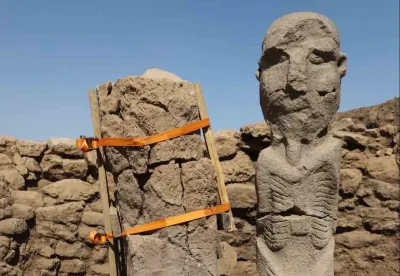
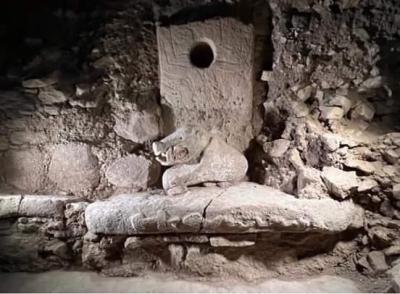
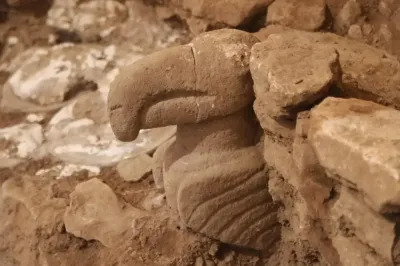 Karahantepe /Göbeklitepe - New finds were discovered in Göbeklitepe and Karahantepe. At around 12,000 years old, Göbekli Tepe is the world’s oldest megalithic site – and it has a “sister site” called Karahantepe. A recent discovery in the world’s oldest religious sanctuary, Göbeklitepe, “Potbelly Hill” in Turkish, which is described as the “zero point of history” has revealed a painted wild boar statue. A painted wild boar statue was discovered during ongoing excavations in Göbeklitepe. The artifact, which contained red, white, and black pigment residues on its surface, was the first painted sculpture found from its period to the present day. As part of the Taş Tepeler project, which sheds light on prehistory and has seen highly significant discoveries on a global scale, the archaeological excavations carried out in 2023 in 9 different areas have recently led to the discovery of human and animal statues. One of the most realistic statue of the era was unearthed, standing at a height of 2.3 meters and featuring a lifelike facial expression in Karahantepe. The similarity of the human statue with the relief found in the Sayburç excavations in 2021 is striking. One of the panels in the Sayburc depicts a figure holding their phallus in his right hand. However, new discovered statue depicts a figure holding its phallus with both hands. This seated statue, which strongly evokes the image of a deceased human with emphasized rib, spinal, and shoulder bones, was discovered within a niche fixed to the ground. In the same area where the sculpture was found, a vulture sculpture placed on the wall, and stone plates left on the ground were also uncovered.
Karahantepe /Göbeklitepe - New finds were discovered in Göbeklitepe and Karahantepe. At around 12,000 years old, Göbekli Tepe is the world’s oldest megalithic site – and it has a “sister site” called Karahantepe. A recent discovery in the world’s oldest religious sanctuary, Göbeklitepe, “Potbelly Hill” in Turkish, which is described as the “zero point of history” has revealed a painted wild boar statue. A painted wild boar statue was discovered during ongoing excavations in Göbeklitepe. The artifact, which contained red, white, and black pigment residues on its surface, was the first painted sculpture found from its period to the present day. As part of the Taş Tepeler project, which sheds light on prehistory and has seen highly significant discoveries on a global scale, the archaeological excavations carried out in 2023 in 9 different areas have recently led to the discovery of human and animal statues. One of the most realistic statue of the era was unearthed, standing at a height of 2.3 meters and featuring a lifelike facial expression in Karahantepe. The similarity of the human statue with the relief found in the Sayburç excavations in 2021 is striking. One of the panels in the Sayburc depicts a figure holding their phallus in his right hand. However, new discovered statue depicts a figure holding its phallus with both hands. This seated statue, which strongly evokes the image of a deceased human with emphasized rib, spinal, and shoulder bones, was discovered within a niche fixed to the ground. In the same area where the sculpture was found, a vulture sculpture placed on the wall, and stone plates left on the ground were also uncovered.
DANEMARK – 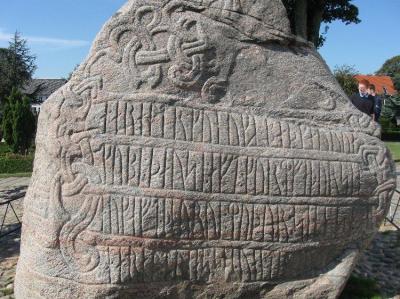 Jelling - Researchers at the National Museum of Denmark using 3D scans have identified who carved the Jelling Stone Runes, located in the town of Jelling, Denmark. The discovery shows that Queen Thyra was far more important than was previously assumed. The Jelling stones are located in the town of Jelling, near the eastern coast of Denmark. They consist of two massive stone monuments that date back to the 10th century CE. The oldest was erected by King Gorm the Old to honor his wife Thyra, while the second stone was raised by his son, Harald Bluetooth to commemorate his parent’s memory. This second stone also contains intricate carvings that describe Harald’s achievements. It celebrates his conquest of Denmark and Norway and how he converted the Danes to Christianity. Harald Bluetooth on the second stone describes himself as “that Haraldr who won for himself all of Denmark and Norway and made the Danes Christian.” 3D scans of runestones enable researchers to gain a close-up view of traces of the carving process. This means they can tell the carving technique of the different rune stones apart. Every experienced stonemason holds his chisel at a certain angle and strikes the hammer with a specific force: this is visible in the angle of the traces of the carving and the distance between them. The motor function developed in such work is individual. The name is Ravnunge-Tue. A runicist from the Viking Age, whose name is hardly well-known among the general public, but who, on the other hand, is quite well-known among professionals. By analyzing these unique features and the distance between them, the team were able to compare the runes on the Jelling stones with others, such as the Laeborg Runestone, which is located about 30 kilometers (18.6 miles) away. This comparison has been invaluable. It turns out the Jelling stones display the same carving techniques as those on the Laeborg Runestone. For this project, seven Jutland runestones were 3D scanned: the two Jelling stones, the two Baekke stones, the Lborg stone, the Home stone, and the Randbl stone. The runes on the smaller Jelling Stone were too worn to see the signature chiseling techniques. It’s possible Ravnunge-Tue carved that one too. The discovery is in itself interesting because it can link another person to the Jelling dynasty, but it is especially interesting because the realization brings with it another startling revelation, explains Lisbeth Imer, runologist and senior researcher at the National Museum in Copenhagen. “The fact that we now know the name of the rune carver of the Jelling Stone is incredible; but what makes the discovery even more amazing is the fact that we know who Ravnunge-Tue’s boss was. She was Queen Thyra of Jelling – mother of Harald Bluetooth, wife of Gorm the Old,” says Lisbeth Imer. The two Jelling stones mention Queen Thyra as the mother of Harald Bluetooth, wife of Gorm the Old and ‘Denmark’s salvation’. However, the name Thyra also appears on two other rune stones: the Læborg Stone, which Ravnunge-Tue carved in memory of Thyra; and Bække 1, which bears the inscription, ‘Ravnunge-Tue and Fundin and Gnyple, these three made Thyra’s mound.’ For many years, researchers have been debating whether the Queen Thyra of the Læborg Stone is the same as the Jelling Thyra. However, based on the new research, the likelihood of two different Thyras is significantly less, because, according to the researchers who conducted the analyses, Ravnunge-Tue carved both the Læborg Stone and the Jelling Stone. That means Queen Thyra was on at least four rune stones, more runic mentions than anyone else in Viking-era Denmark, twice the number of mentions her husband and son got. Lisbeth Imer believes that this also highlights just how important Queen Thyra was. “This means that Queen Thyra was far more important than we previously assumed. She probably came from a nobler, older family than Gorm the Old, whom we usually refer to as the first King of Denmark. This is extremely interesting when it comes to understanding the power structure and the genesis of Denmark as a nation,” says Lisbeth Imer. All four rune stones that mention Thyra are located in Southern Jutland, implying that her power was based in this area, while Gorm the Old may have come from elsewhere.
Jelling - Researchers at the National Museum of Denmark using 3D scans have identified who carved the Jelling Stone Runes, located in the town of Jelling, Denmark. The discovery shows that Queen Thyra was far more important than was previously assumed. The Jelling stones are located in the town of Jelling, near the eastern coast of Denmark. They consist of two massive stone monuments that date back to the 10th century CE. The oldest was erected by King Gorm the Old to honor his wife Thyra, while the second stone was raised by his son, Harald Bluetooth to commemorate his parent’s memory. This second stone also contains intricate carvings that describe Harald’s achievements. It celebrates his conquest of Denmark and Norway and how he converted the Danes to Christianity. Harald Bluetooth on the second stone describes himself as “that Haraldr who won for himself all of Denmark and Norway and made the Danes Christian.” 3D scans of runestones enable researchers to gain a close-up view of traces of the carving process. This means they can tell the carving technique of the different rune stones apart. Every experienced stonemason holds his chisel at a certain angle and strikes the hammer with a specific force: this is visible in the angle of the traces of the carving and the distance between them. The motor function developed in such work is individual. The name is Ravnunge-Tue. A runicist from the Viking Age, whose name is hardly well-known among the general public, but who, on the other hand, is quite well-known among professionals. By analyzing these unique features and the distance between them, the team were able to compare the runes on the Jelling stones with others, such as the Laeborg Runestone, which is located about 30 kilometers (18.6 miles) away. This comparison has been invaluable. It turns out the Jelling stones display the same carving techniques as those on the Laeborg Runestone. For this project, seven Jutland runestones were 3D scanned: the two Jelling stones, the two Baekke stones, the Lborg stone, the Home stone, and the Randbl stone. The runes on the smaller Jelling Stone were too worn to see the signature chiseling techniques. It’s possible Ravnunge-Tue carved that one too. The discovery is in itself interesting because it can link another person to the Jelling dynasty, but it is especially interesting because the realization brings with it another startling revelation, explains Lisbeth Imer, runologist and senior researcher at the National Museum in Copenhagen. “The fact that we now know the name of the rune carver of the Jelling Stone is incredible; but what makes the discovery even more amazing is the fact that we know who Ravnunge-Tue’s boss was. She was Queen Thyra of Jelling – mother of Harald Bluetooth, wife of Gorm the Old,” says Lisbeth Imer. The two Jelling stones mention Queen Thyra as the mother of Harald Bluetooth, wife of Gorm the Old and ‘Denmark’s salvation’. However, the name Thyra also appears on two other rune stones: the Læborg Stone, which Ravnunge-Tue carved in memory of Thyra; and Bække 1, which bears the inscription, ‘Ravnunge-Tue and Fundin and Gnyple, these three made Thyra’s mound.’ For many years, researchers have been debating whether the Queen Thyra of the Læborg Stone is the same as the Jelling Thyra. However, based on the new research, the likelihood of two different Thyras is significantly less, because, according to the researchers who conducted the analyses, Ravnunge-Tue carved both the Læborg Stone and the Jelling Stone. That means Queen Thyra was on at least four rune stones, more runic mentions than anyone else in Viking-era Denmark, twice the number of mentions her husband and son got. Lisbeth Imer believes that this also highlights just how important Queen Thyra was. “This means that Queen Thyra was far more important than we previously assumed. She probably came from a nobler, older family than Gorm the Old, whom we usually refer to as the first King of Denmark. This is extremely interesting when it comes to understanding the power structure and the genesis of Denmark as a nation,” says Lisbeth Imer. All four rune stones that mention Thyra are located in Southern Jutland, implying that her power was based in this area, while Gorm the Old may have come from elsewhere.
ITALIE - -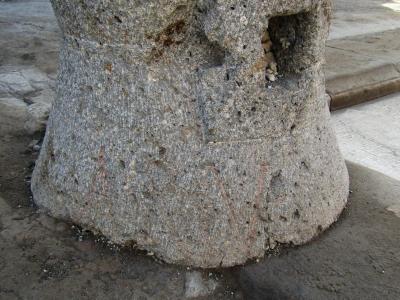
 Pompéi - Several electoral inscriptions, the ancient equivalent of today’s electoral posters and pamphlets, have appeared on the walls of the room that housed the Lararium, the domestic altar of the house, inside a house on the Via di Nola, in the central area of ancient Pompeii. It turns out that there was already an exchange of votes back then as reported in the online scientific magazine of the Pompeii Archaeological Park, the E-Journal of the Pompeii Excavation. Not only that, the excavations also revealed the last sacrifice on the domestic altar which probably occurred before the eruption. The fact that they were found inside the house was surprising because normally these inscriptions were placed on the exterior facades of buildings, where citizens could read the names and qualifications of the candidates for the city’s magistracies. Archaeologists explain the presence of electoral propaganda inside the house because the practice of organizing events and dinners inside the homes of the candidates and their friends to promote the electoral campaign was common. The team discovered electoral inscriptions in support of Aulus Rustius Verus, a candidate for the position of aedile. Aediles were in charge of maintaining public buildings (aedēs) and regulating public festivals. The office of the aediles was typically held by young men aspiring to high political office, traditionally after their quaestorship but before their praetorship. In this case, the signs encourage voting for a certain Aulus Rustius Verus for the position of aedile, in ancient Rome a type of councilor who was in charge of public works. Aulus Rustius Verus’s name appears in other inscriptions and is known in Pompeii for having held the highest public office in the city in the seventies of the 1st century AD, along with Giulio Polibius, owner of a splendid house on the Avenue of Abundance. , that of duovirea degree that was accessed after having been aedile, so archaeologists deduce that the newly discovered inscriptions are ancient and that Aulus Rustius Verus probably won those elections. The house apparently belonged to a supporter of Aulus Rustius, perhaps one of his freedmen or a friend, and houses a detail that has not gone unnoticed by archaeologists: a bakery with a large oven, near which the bodies of three victims, two women, and a child, killed by the attic collapse during the first phase of the eruption. Maria Chiara Scappathiccio, professor of Latin at the Federico II University of Naples and co-author of the study of the new findings, explained that the councilors and the bakers “collaborated to the limits of legality” and that Aulus Rustius Verus “was able to realize very “soon, when he was still in the middle of the electoral campaign to become mayor, that the voter lives above all on bread.” The discovery of the candidate’s initials, ARV, on a volcanic stone millstone, resting in the hall of the house, where renovation work was taking place at the time of the eruption, supports this thesis. “Aulus Rustius Verus probably directly financed the bakery’s activity, both for economic and political purposes,” said Maria Chiara Scappathiccio. Furthermore, on the altar of the great Larario, decorated with two stucco snakes, the remains of a last votive offering have been found, probably occurring shortly before the eruption. Scientists have analyzed the remains and discovered that the ritual consisted of offering figs and dates that were burned in front of the altar. To close the rite, a whole egg was placed directly on the masonry altar of the lararium. The altar was then covered with a tile. Remains of previous offerings were also found, which also included vine fruits, fish and mammal meat.
Pompéi - Several electoral inscriptions, the ancient equivalent of today’s electoral posters and pamphlets, have appeared on the walls of the room that housed the Lararium, the domestic altar of the house, inside a house on the Via di Nola, in the central area of ancient Pompeii. It turns out that there was already an exchange of votes back then as reported in the online scientific magazine of the Pompeii Archaeological Park, the E-Journal of the Pompeii Excavation. Not only that, the excavations also revealed the last sacrifice on the domestic altar which probably occurred before the eruption. The fact that they were found inside the house was surprising because normally these inscriptions were placed on the exterior facades of buildings, where citizens could read the names and qualifications of the candidates for the city’s magistracies. Archaeologists explain the presence of electoral propaganda inside the house because the practice of organizing events and dinners inside the homes of the candidates and their friends to promote the electoral campaign was common. The team discovered electoral inscriptions in support of Aulus Rustius Verus, a candidate for the position of aedile. Aediles were in charge of maintaining public buildings (aedēs) and regulating public festivals. The office of the aediles was typically held by young men aspiring to high political office, traditionally after their quaestorship but before their praetorship. In this case, the signs encourage voting for a certain Aulus Rustius Verus for the position of aedile, in ancient Rome a type of councilor who was in charge of public works. Aulus Rustius Verus’s name appears in other inscriptions and is known in Pompeii for having held the highest public office in the city in the seventies of the 1st century AD, along with Giulio Polibius, owner of a splendid house on the Avenue of Abundance. , that of duovirea degree that was accessed after having been aedile, so archaeologists deduce that the newly discovered inscriptions are ancient and that Aulus Rustius Verus probably won those elections. The house apparently belonged to a supporter of Aulus Rustius, perhaps one of his freedmen or a friend, and houses a detail that has not gone unnoticed by archaeologists: a bakery with a large oven, near which the bodies of three victims, two women, and a child, killed by the attic collapse during the first phase of the eruption. Maria Chiara Scappathiccio, professor of Latin at the Federico II University of Naples and co-author of the study of the new findings, explained that the councilors and the bakers “collaborated to the limits of legality” and that Aulus Rustius Verus “was able to realize very “soon, when he was still in the middle of the electoral campaign to become mayor, that the voter lives above all on bread.” The discovery of the candidate’s initials, ARV, on a volcanic stone millstone, resting in the hall of the house, where renovation work was taking place at the time of the eruption, supports this thesis. “Aulus Rustius Verus probably directly financed the bakery’s activity, both for economic and political purposes,” said Maria Chiara Scappathiccio. Furthermore, on the altar of the great Larario, decorated with two stucco snakes, the remains of a last votive offering have been found, probably occurring shortly before the eruption. Scientists have analyzed the remains and discovered that the ritual consisted of offering figs and dates that were burned in front of the altar. To close the rite, a whole egg was placed directly on the masonry altar of the lararium. The altar was then covered with a tile. Remains of previous offerings were also found, which also included vine fruits, fish and mammal meat.
Electoral inscriptions just discovered in Pompeii reveal clientelism in ancient Rome - Arkeonews
GRECE – 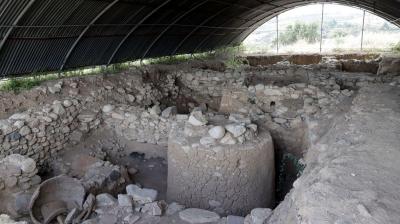
 Serres - Archaeologists have uncovered an ancient city in Palaiokastro, Serres, Greece. The ancient city appears to have been founded at the end of the 6th century BC and remained in existence into the 6th century AD. Archaeologists who have been conducting research in the area for the second year are part of a team led by the Serres Antiquities Ephorate in collaboration with the French School of Athens. They have discovered impressive monuments and gathered data that add to what is already known about the history of this Ancient Greek city. Archaeologists hope to correctly identify name of ancient city “Paleokastro’s location is identified with one of the ancient cities of the lower valley of Struma known [since] ancient historical sources,” the Head of the Ephorate of Antiquities of Serres, Dimitria Malamidou, told AMNA. “We hope that with the new research there will be findings (inscriptions, coins) that will allow the safe identification of the city’s name,” Malamidou said. “However, it is already obvious that its strategic position between the fertile valley of the river Struma and the slopes of the ore-rich mountains of Kerdyllion and Vertiskos, contributed to its long and successful history.” “It is no coincidence that among the oldest finds, an inscription stands out that mentions the word ‘adamaϛ,’ a term that refers to gold and probably to its exploitation” she added. The findings have revealed that the area was initially under the control of the Thracian tribe of the Bisaltians. However, it was later settled by Greeks from the cities of the South and the Macedonian Kingdom. Findings of the excavations prove the presence of Greek pottery as early as the 6th century BC. Excavations have also unearthed Hellenistic-era building phases, part of the fortification, a Roman basilica with a complex of thermal baths, a workshop with wine presses (cistern) of Roman times, and two Christian churches of the three-aisled basilica type. Several tombs from various eras have been excavated on its territory, as well as a Macedonian type tomb belonging to the brothers Ipponakta and Dioscorides. The latter were sons of Apollodorus, who was, according to historical sources, a comrade of Alexander the Great, “says the Head of the Ephorate of Antiquities of Serres.” The first time archaeologists began conducting research in the area was in 1965. According to Malamidou, it was Eugenia Giouri who discovered a “Macedonian-type” tomb at a distance of about two kilometers east of Paleokastro.The tomb was dated in accordance with a coin around 328 BC. According to the inscriptions engraved inside the tomb, it belonged to the brothers Ipponakta and Dioskourides, who were the sons of Apollodorus, the partner of Alexander the Great, who had settled in Amphipolis.
Serres - Archaeologists have uncovered an ancient city in Palaiokastro, Serres, Greece. The ancient city appears to have been founded at the end of the 6th century BC and remained in existence into the 6th century AD. Archaeologists who have been conducting research in the area for the second year are part of a team led by the Serres Antiquities Ephorate in collaboration with the French School of Athens. They have discovered impressive monuments and gathered data that add to what is already known about the history of this Ancient Greek city. Archaeologists hope to correctly identify name of ancient city “Paleokastro’s location is identified with one of the ancient cities of the lower valley of Struma known [since] ancient historical sources,” the Head of the Ephorate of Antiquities of Serres, Dimitria Malamidou, told AMNA. “We hope that with the new research there will be findings (inscriptions, coins) that will allow the safe identification of the city’s name,” Malamidou said. “However, it is already obvious that its strategic position between the fertile valley of the river Struma and the slopes of the ore-rich mountains of Kerdyllion and Vertiskos, contributed to its long and successful history.” “It is no coincidence that among the oldest finds, an inscription stands out that mentions the word ‘adamaϛ,’ a term that refers to gold and probably to its exploitation” she added. The findings have revealed that the area was initially under the control of the Thracian tribe of the Bisaltians. However, it was later settled by Greeks from the cities of the South and the Macedonian Kingdom. Findings of the excavations prove the presence of Greek pottery as early as the 6th century BC. Excavations have also unearthed Hellenistic-era building phases, part of the fortification, a Roman basilica with a complex of thermal baths, a workshop with wine presses (cistern) of Roman times, and two Christian churches of the three-aisled basilica type. Several tombs from various eras have been excavated on its territory, as well as a Macedonian type tomb belonging to the brothers Ipponakta and Dioscorides. The latter were sons of Apollodorus, who was, according to historical sources, a comrade of Alexander the Great, “says the Head of the Ephorate of Antiquities of Serres.” The first time archaeologists began conducting research in the area was in 1965. According to Malamidou, it was Eugenia Giouri who discovered a “Macedonian-type” tomb at a distance of about two kilometers east of Paleokastro.The tomb was dated in accordance with a coin around 328 BC. According to the inscriptions engraved inside the tomb, it belonged to the brothers Ipponakta and Dioskourides, who were the sons of Apollodorus, the partner of Alexander the Great, who had settled in Amphipolis.
Long Lost Ancient City Discovered in Serres, Greece (greekreporter.com)